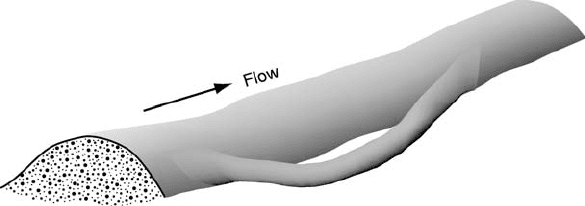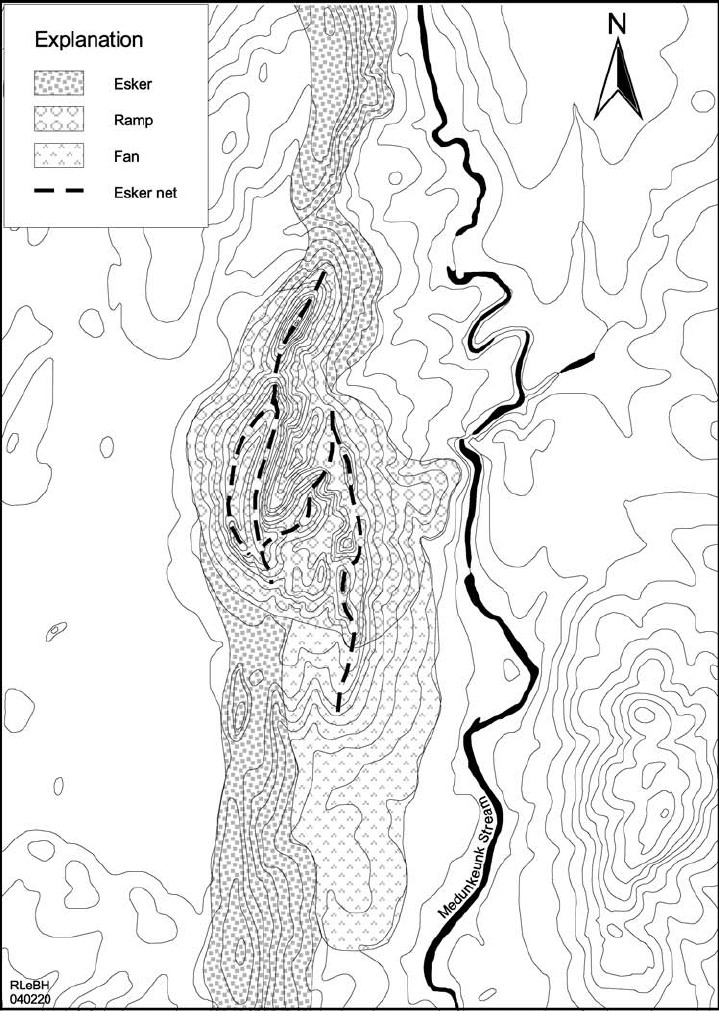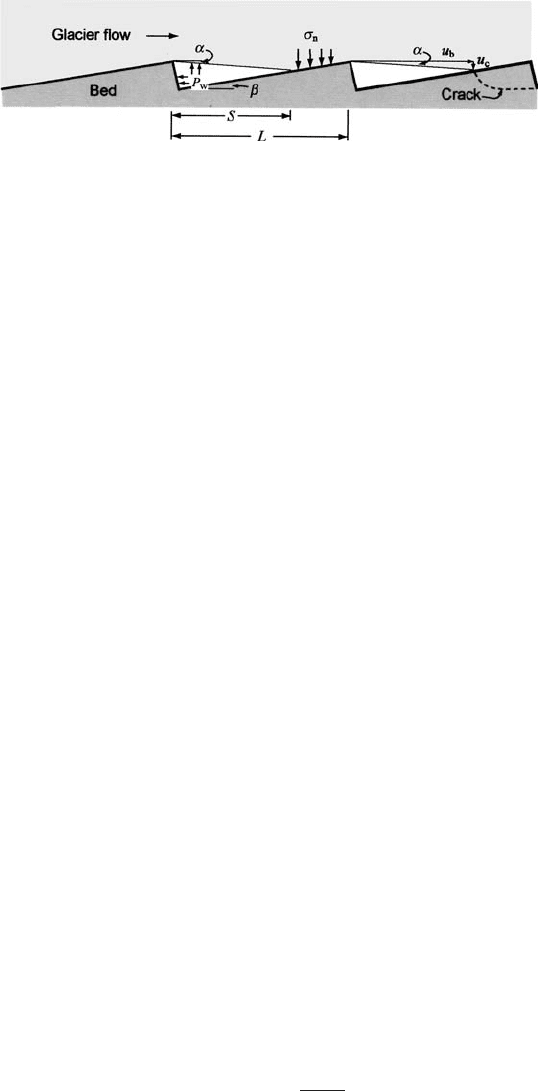Hooke R.L. Principles of glacier mechanics
Подождите немного. Документ загружается.


Tunnel valleys 241
Figure 8.29. Sketch of small
daughter esker diverging from
and later rejoining parent
esker. This may occur near the
margin where the ice is thin
and conduit closure rates are
low. (Bruce Hooke assisted
with artwork.)
massive wedge-shaped deposit that increases in height downstream.
Steep distal slopes mark the downstream ends of these wedges, which I
call ramp structures.
Esker nets were apparently first described by Stone (1899), who
called them reticulate eskers. A particularly good example is found in a
valley called Atnedalen in Norway. Following the esker down-flow, one
first encounters several situations in which a small esker drops down
off the side of the parent, parallels it for a short distance, and then
climbs back up onto it again (Figure 8.29). This is probably because
the ice thickness required to keep the conduit on top of the esker was
becoming marginal. Closer to the ice margin, where the ice was still
thinner, these daughter eskers grow to nearly the same size as the parent,
forming an anastomosing pattern of ridges. Still further downstream, the
ridge character becomes indistinct and the system merges into a kettled
outwash plain.
Esker nets and ramps are characteristic of the Katahdin esker. A
typical segment of the esker begins as a relatively small, sharp-crested
ridge. Down flow, the ridge increases in size, at first rather gradually,
but near the end more rapidly. Some segments end in ramps. Others
end in esker nets or in a combination of the two forms (Figure 8.30).
Downstream from ramps and esker nets there is commonly either a fan
or a delta built into the sea in which the glacier terminated. These fans
and deltas are composed of sand and fine gravel that was flushed through
the enlarged conduit as coarser material was deposited. The transition
from ramp to fan has been described well by Ashley et al. (1991,p.112).
The next segment down flow may develop from a continuation of one of
the ridges in an esker net, may emerge from a fan or delta, or may pick
up after a short gap.
Tunnel valleys
The margins of many ice lobes of the southern Laurentide Ice Sheet
are marked by broad, relatively straight valleys, oriented normal to

242 Water flow in and under glaciers
Figure 8.30. Map of a section of the Katahdin esker showing a ramp and esker
net. There is a fan down-flow from the ramp. (The site is 4.5 km NNE of Lincoln
Center, Maine.)
Tunnel valleys 243
the former ice margin. These features, apparently first described by
Ussing (1903) from Jylland in Denmark, are called tunnel valleys. They
are typically 10–20 km long, although they may be shorter or longer;
afew hundred meters wide; and ∼10 m deep, though depths as great
as 70 m have been reported (Wright, 1973) and the depth of any fill
is generally not known. Small eskers are occasionally associated with
the valleys (Johnson, 1999; Mooers 1989), and some valleys have tribu-
taries or distributaries. The valleys end at former ice margins, where they
debouch onto proglacial gravel fans. Thus, they must have been formed
subglacially. The lack of evidence for modification by overriding ice
implies that any subsequent ice movement was probably not very vigor-
ous. Some tunnel valleys in Minnesota trend across the regional gradient
and are cross cut by present stream courses (Wright, 1973). Others ascend
adverse gradients near their termini (Cutler et al., 2002; Mooers, 1989).
Both characteristics suggest that they were excavated by pressurized sub-
glacial water. Mooers describes one situation in which a tunnel valley
terminating at one recessional moraine is cross cut by a younger tunnel
valley terminating at a younger recessional moraine. The process of for-
mation thus must have been intermittent, with the earlier valley becoming
completely closed, presumably by infilling with ice, before the later one
formed. Tunnel valleys are rare or absent along the most southerly margin
of the Laurentide Ice Sheet, suggesting that they may be characteristic
of colder environments where frozen bed conditions were likely to have
been present along the ice margin (Cutler et al., 2000). This, however, is
controversial.
The origin of the water and the nature of the flows that cut the tunnel
valleys are actively debated. Was the water from basal melt alone, or
was there a contribution from the surface? Was the water flow contin-
uous over a period of decades or centuries, or was the water released
catastrophically? Wright argued for a catastrophic release of subglacial
water because he thought that a number of tunnel valleys were carved
simultaneously and that the ice was cold enough to preclude drainage
from the surface. Cutler et al. found that some fans at the ends of tun-
nel valleys consisted of tens of meters of sand and gravel overlain by
a bed, 3–5 m thick, containing boulders up to 2 m in diameter. They
thought the gravel might have been deposited by superglacial melt-
water reaching the bed through moulins near the margin. The boulder
bed, however, seemed to require a water flux greater than could be sup-
plied by superglacial water or by steady-state basal melt. Accordingly,
they suggested that it was deposited by subglacial water that was released
when a seal was breached. They believed that the seal was a marginal
zone in which the ice was frozen to the bed. Relict permafrost features,

244 Water flow in and under glaciers
Figure 8.31. Bed geometry and parameters used in Hallet’s (1996) analysis of
glacier quarrying.
pollen evidence, and numerical modeling all suggest that a wedge of
frozen ground might well have extended several kilometers in under the
ice sheet at this time (as in the left diagram in Figure 6.16). Patterson
(2002) thinks that sapping, driven by the high gradient in hydraulic head
across a marginal seal, may be an important process in initiating an
outburst.
Water pressure and glacier quarrying
Quarrying is an important process of glacier erosion. In quarrying, blocks
of bedrock must first be loosened, either along preglacial joints or along
fractures formed by subglacial processes. Then they must be entrained
by the glacier. Because rock fragments that have been loosened but not
removed are uncommon on deglaciated bedrock surfaces, Hallet (1996)
argues that loosened blocks are readily entrained. He thus concludes that
fracture must be the rate-limiting process.
To analyze the stresses causing fracture, Hallet considers an idealized
bed consisting of steps as shown in Figure 8.31. The distance between
steps is L. The treads slope upglacier at an angle β. The crests of the steps
are at the same elevation, so the average bed slope is 0. Ice sliding over
the crest of one step separates from the bed, forming a water-filled cavity
under pressure P
w
. The ice regains contact with the bed a distance S from
the crest. The slope of the cavity roof is α. The glacier is supported in
part by water in the cavity and in part by a vertical stress, σ
n
,onthe crest
of the step, so summing forces:
P
i
L = P
w
S + σ
n
(L − S) (8.28)
The slopes α and β are related by:
S tan α = (L − S) tan β (8.29)
From Equation (8.28), noting that the effective pressure (or pressure
causing closure of the cavity), P
c
,isP
i
− P
w
,weobtain:
σ
n
= P
i
+ P
c
S
L − S
(8.30)

Water pressure and glacier quarrying 245
Now σ
n
acts on the crest of a step, promoting fracture, but P
w
supports
the rock face, resisting fracture. Thus, the total stress causing fracture
(the non-hydrostatic or deviatoric stress – see Chapter 2) is:
σ
n
= σ
n
− P
w
= P
c
L
L − S
(8.31)
To determine σ
n
we need to know S.
Hallet assumes that the rate of closure of the cavity roof, u
c
, can be
approximated by a relation of the form of Equation (8.3), thus:
u
c
= kSP
3
c
(8.32)
where k is a constant involving, among other things, the ice viscosity
parameter, B.Ifu
c
is considered to be vertical and uniform over the
cavity roof and u
b
is the horizontal sliding speed, then:
tan α =
u
c
u
b
(8.33)
Combining Equations (8.29), (8.32), and (8.33) then yields
1
:
S
2
kP
3
c
u
b
+ S tan β − L tan β = 0 (8.34)
Thus, for a given L, P
c
, u
b
, and β, Equation (8.34) can be solved for S
and Equation (8.31) then gives σ
n
.
Hallet then uses principles of fracture mechanics (Chapter 4), into
which we will not delve further here, to estimate the rate of crack growth.
In his calculations, deviatoric stresses in the ice are constrained to be less
than the tensile strength of ice. By assuming that the crack is initiated
at a distance (L − S) from the crest of the step (Figure 8.31), he then
calculates the quarrying rate (Figure 8.32) for two rock types, a gran-
ite and a marble. The softer marble erodes 1000 times faster than the
granite!
As expected, quarrying rates increase with sliding speed. In addi-
tion, as u
b
increases maximum quarrying rates occur at higher effective
pressures. To understand the latter, note in Equation (8.31) that as S →L,
the term in brackets increases without bound. An increase in S can result
either from an increase in u
b
or from a decrease in P
c
. This is because
both of these changes cause ice in the roof of the cavity to regain contact
with the bed further from the crest of the preceding step. If an increase
in S is a consequence of a decrease in P
c
, σ
n
does not increase so much
because the two effects offset one another in Equation (8.31) (note that
S = L when P
c
= 0 because the glacier is then afloat). Thus, quarrying
1
This differs from Hallet’s analysis because he takes u
c
to be normal to the cavity roof.
Considering the approximations in Equation (8.32) and the simplifications achieved by
using Equation (8.33), taking u
c
to be vertical seems justified.

246 Water flow in and under glaciers
Figure 8.32. Theoretical
rates of quarrying of marble
(solid lines) and granite
(dashed lines) on a bed like
that shown in Figure 8.31.
Parameters used in the
calculation were L = 10 m,
β =11.5
o
, and k =5a
−1
MPa
−3
.
(Based on Hallet, 1996,
Figure 2. Reproduced with
permission of the author and
the International Glaciological
Society.)
rates have maxima at some fairly low P
c
(Figure 8.32). On the other
hand, if the increase in S is a consequence of an increase in u
b
, then
the maxima in σ
n
and the quarrying rate can occur at a higher P
c
. Also
noteworthy in Figure 8.32 is the sensitivity of the quarrying rate to P
c
;
under 450 m of ice, for example, P
c
may vary from 0 to ∼4 MPa, but
significant erosion occurs over <10% of that range.
Because stresses that can be generated in the rock in this way are
limited by the tensile strength of ice, the maximum steady σ
n
that can
be applied to a rock is about 10 MPa, while tensile strengths of strong
crystalline rocks without macroscopic flaws generally range from 10 to
20 MPa (Hallet, 1996). Water-pressure fluctuations in cavities in the lee
of a bump on a glacier bed provide a mechanism for fracturing this strong
rock. They also accelerate propagation of fractures in weaker rocks or
those with macroscopic flaws and play a role in the entrainment process
(R¨othlisberger and Iken, 1981;Iverson, 1989). Let us consider fracture
first.
Water-pressure fluctuations are particularly rapid where moulins
provide connections from the surface of a glacier to the bed. Water
inputs from rain or melt can then cause subglacial cavities to fill and
drain faster than they can adjust by flow of the ice. The resulting pres-
sure fluctuations transfer the weight of the glacier first to and then from
the tops of bumps. Under 250 m of ice, for example, the pressure could
Water pressure and glacier quarrying 247
vary from a relatively uniform 2.2 MPa on all faces of a bump to over
12 MPa, say, on the top, and nearly zero on the lee face.
All rocks contain microcracks, fractions of a millimeter to a few
millimeters in length, and the stress variations resulting from these water
pressure fluctuations can lead to propagation of tensile fractures at the
tips of favorably oriented cracks (Griffith, 1924). This can occur even
at stresses well below the experimentally determined tensile strength of
the rock (Atkinson and Rawlings, 1981; Atkinson, 1984;Segall, 1984).
The likelihood of crack growth increases when the water pressure within
cracks remains elevated while that in an adjacent cavity drops, or when
stress corrosion resulting from repeated pressure changes reduces the
strength of the rock (Iverson, 1991). Even higher and more concentrated
stress differences can result when a cobble or boulder is dragged over a
bump by the ice. Thus, it now seems safe to conclude that even sound
crystalline rocks can be fractured subglacially through the action of ice
and water, despite the fact that the ice is weaker than the underlying
rock.
Boulders with smooth stoss faces and plucked lee faces that are
embedded in till, called bullet boulders, provide convincing field evi-
dence for subglacial fracture (see, for example, Sharp, 1982). These boul-
ders must have been transported by the ice and become lodged in the till as
the basal ice melted. They would not have had their characteristic shape
prior to lodgement, nor could they have been transported to their present
location, intact, if they had pre-existing fractures. Thus their shape
must have been produced by the overriding glacier after they became
lodged.
Once a block of rock is isolated by fractures, bed-parallel forces
tending to slide it out of position must exceed frictional forces tending
to hold it in place in order for entrainment to occur (Iverson, 1989). Both
the bed-parallel and the frictional forces are affected by fluctuations in
water pressure. As noted earlier (Figure 7.6), pressure-release freezing
may occur on tops of bumps when increases in water pressure in cavities
transfer part of the weight of a glacier away from the bumps (Robin,
1976), and similar cold patches can also develop owing to simple flow
of the ice from the stoss side of a bump to its crest. Both processes
increase the drag exerted by the ice on the block. The latter process
is more effective at higher sliding velocities, so increases in subglacial
water pressure that cause increases in sliding speed should increase its
effectiveness.
Frictional forces resisting dislodgement of loosened blocks are
reduced as water pressures rise (Iverson, 1989). This is because the
normal pressure that ice exerts on a bedrock surface upglacier from a

248 Water flow in and under glaciers
1700
1500
1300
1100
Elevation, masl
3.53.02.01.00
Distance from head, km
Riegel
Bergschrund
Crevasse
zones
Ver tical exaggeration 2x
w.e.l.
Main over-
deepening
Figure 8.33. Longitudinal section of Storglaci
¨
aren, Sweden, approximately
along a flowline showing cirque, overdeepened basins, water-input points
(crevasse zones and bergschrund), and inferred locations of quarrying (indicated
by ). Here w.e.l. = water equivalent line; circles (o) show heights of water
in boreholes. (Modified from Hooke, 1991, Figure 2.)
cavity is reduced, thus decreasing the friction along fractures that bound
loosened blocks. In addition, once fractures are well-developed and in
hydraulic communication with cavities, increases in water pressure in
the fractures themselves reduce the effective pressure across fracture
surfaces.
In summary, it appears that steady flow and low effective pressures
can fracture weaker rocks or rocks with macroscopic flaws. However,
fluctuations in subglacial water pressure and associated transient changes
in glacier sliding speed facilitate quarrying, particularly of more resis-
tant lithologies. Abrupt reductions in water pressure promote subglacial
fracture while increases, whether rapid or more gradual, promote the
dislodgement of loosened blocks.
Origin of cirques and overdeepenings
Cirques and overdeepened basins in glacier beds, such as those in Figure
8.33, are similar in form. Both have steep headwalls and both tend to
have beds with adverse slopes. We will discuss the headwalls first.
Headwalls have ragged surfaces, apparently resulting from frac-
ture and removal of blocks of rock. This morphology suggests that
they are eroded by glacial quarrying. As we have just discussed, quar-
rying appears to be a result of water-pressure fluctuations on time
scales of hours to days. These fluctuations seem to be most pronounced
close to areas of water input (Hooke, 1991). In the case of cirques,
the water input is localized by the bergschrund, and in the case of
overdeepenings, by crevasses that form over the convexities at their heads
Origin of cirques and overdeepenings 249
(Figure 8.33). Thus, these water inputs and resulting pressure fluctua-
tions occur at precisely the points where erosion is necessary to maintain
the headwalls.
In the case of the headwall of an overdeepening, a positive-feedback
process appears to be operating. Crevassing over a minor convexity in
the bed, an initial perturbation, localizes water input and hence erosion.
The erosion is concentrated on the downglacier side of the convexity.
Thus, as the erosion progresses, the convexity is amplified, resulting in
further crevassing.
The other defining characteristic of cirques and overdeepenings is
the gentle adverse slope of their beds. The steepness of this slope may
be limited by the ability of water to flow along the bed. For example, if
k = 0.309 and ρ = 916 kg m
−3
in Equation (8.12), it is easy to show (by
using Equation (8.5)) that
˙
m = 0when dz/ds =−1.7 dH/ds. (This is
left as an exercise for the reader. Note that the constant of proportionality
is lower if the water is partially or completely saturated with air and a
higher value of k is thus used.) In other words, when the adverse bed
slope, dz/ds,is1.7 times the surface slope, all of the energy dissipated
in the flowing water is needed to warm the water to keep it at the pressure
melting point as the ice thins in the downglacier direction, and none is
available to melt more ice (see Equation (8.10) and discussion of Figure
8.11c). Where the adverse slope is steeper, Equation (8.12) predicts,
mathematically, that
˙
m should become negative, so water should freeze
in the conduit, and Equation (8.24) then predicts that P
w
> P
i
. Indeed,
measured water pressures in the main overdeepening of Storglaci¨aren
are quite close to the overburden pressure (Figure 8.33).
Actually, field data suggest that the water, rather than remaining in the
conduit, spreads out in a maze of linked water pockets with flow velocities
that are too low to move significant amounts of sediment (Figure 8.22).
If the adverse slope is steep enough, frazil ice (platelets of ice that form
in the flowing water) may form and further inhibit flow. Because the
subglacial drainage system is thus disrupted in overdeepenings, water is
forced to follow englacial conduits through them (Hooke and Pohjola,
1994).
Where subglacial streams are thus not available to flush out the
products of erosion, a layer of till must accumulate. Substantial amounts
of this sediment can be entrained if frazil ice forms and is eventually
incorporated into the glacier sole (Lawson et al., 1998). Continuity con-
siderations suggest that the till layer will increase in thickness until the
downglacier mass transfer by deformation within it and entrainment by
frazil ice at its surface equals sediment production by erosion. Such a
sediment layer would protect the bed throughout the downglacier reaches
250 Water flow in and under glaciers
of an overdeepening, thus concentrating erosion at its head. This is prob-
ably why overdeepenings exist, and why their longitudinal profiles are
characteristically asymmetrical with the deepest point at their upglacier
ends (Hooke, 1991).
Summary
In this chapter we have investigated the glacier hydraulic system, start-
ing with the vein network along lines of intersection among three ice
crystals and progressing through the englacial to the subglacial system.
We found that theoretically water flow in the englacial system should be
normal to equipotential surfaces that dip upglacier at an angle roughly
11 times the slope of the glacier surface. Along the bed, water flow
is normal to the intersections of these equipotential surfaces with the
bed.
Water moving through conduit systems in or beneath glaciers
releases viscous energy. This energy melts ice on conduit walls. However,
the pressure in the water is generally less than that in the surrounding
ice, so the conduits close by creep. In the steady state, the water pressure
is everywhere adjusted so that u =
˙
m. Along the bed u is inhibited by
drag. In addition, melting is concentrated low on the walls when tunnels
are not full of water. Thus, the steady-state conduit shape is likely to be
broad and low.
The water pressure in conduits increases upglacier, approximately
in proportion to the increase in ice thickness over the conduit. In conduit
systems consisting of tunnels, P
w
decreases as Q increases, but in sys-
tems consisting of cavities in the lee of bedrock steps linked by orifices,
P
w
increases as Q increases. Thus, tunnel systems are believed to be
arborescent, while linked-cavity systems are distributed. In all probabil-
ity, these are end members of a continuum of drainage system types.
Tunnel systems are likely to collapse when discharges are low, tun-
nels are shrinking, and water pressures are increasing. If the tunnel sys-
tem cannot regenerate when discharges increase again, water pressures
may rise high enough to initiate a surge.
In conduits between a glacier and a deformable bed, the steady-state
condition is one in which, in addition to u =
˙
m, erosion of sediment by the
flowing water must balance the flux of sediment into the conduit. Under
these conditions, conduit systems are likely to be distributed. Analysis
suggests that this condition is most likely when glacier surface slopes
are low and water pressures high, as is commonly the case beneath ice
sheets. Beneath valley glaciers, water pressures are typically lower, so
bed deformation is not as likely.
